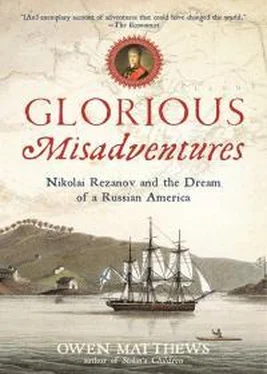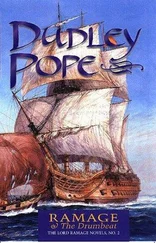19 Simon Sebag Montefiore, Potemkin: Catherine the Great’s Imperial Partner , Vintage, London 2005, p. 349.
20 20 August 1795, quoted in Ibid., p. 414.
21 Catherine to Vyazemsky, January 1764. He served until 1792. Quoted in Dixon, Catherine the Great , p. 134.
22 Orlando Figes, Natasha’s Dance , Picador 2003, p. 3.
23 Sebag Montefiore, Potemkin , p. 425.
24 Dixon, Catherine the Great , p. 132.
25 Kazimierz Waliszewski, Paul the First of Russia, the Son of Catherine the Great , William Heineman, New York 1913, p. 143.
26 Adami, Eine schwierige Nachbarschaft , pp. 83–91, quoted in Moessner, ‘The First Russian Ambassador to Japan’.
27 Nikolai Rezanov to Mikhail M. Buldakov, Kamchatka, 6 June 1805, quoted in Alexei Alexandrovich Istomin, ‘Dva Varianta Pisma N. P. Rezanova Grafu N P Rumiantsevu ot 17/29 iyulya 1806 g. – Sravnitelno-tekhnologichesky analyz I legenda o velikoi lyubvi’, Russkoe Otkritiye Ameriki, M, Moscow 2002.
28 John D’Wolf, A Voyage to the North Pacific and a Journey Through Siberia More than Half a Century Ago , Boston 1861 (facsimile edition Ye Galleon Press, Fairfield 1968), p. 30.
29 Rezanov’s final instructions to Baranov quoted in Viktor Lopatnikov, ‘Nikolai Rezanov’, Zolotoi Lev , no. 127–8, RFS, Moscow 2007.
4. King of Siberia
1 30 November 1793, quoted in Wilhelm Lagus, Eric Laxman, his Life, Voyages, Discoveries and Correspondence , St Petersburg 1890, p. 269.
2 This remarkable Irkutsk merchantwoman was the first Russian to transcribe the folk tale Kolobok , about a ball of dough which rolls away from its grandparents to freedom and is eaten by a fox. Ekaterina Avdeeva-Polevaya and Alexei Polevoi, Zapiski , quoted in Black, Russians in Alaska , p. 111.
3 Natalia Shelikhova, ed. and tr. by Dawn Lea Black, Alexander Petrov and Marvin W. Falk, Natalia Shelikhova, Russian Oligarch of Alaska Commerce , University of Alaska Press, Fairbanks 2010, p. xvii.
4 Or possibly Trapeznikova, daughter of a wealthy merchant and Old Believer from the northern Dvina. M. I. Tsiporukha in his essay ‘Odna iz Stroitelei Imperii na Tikhookeanskom Severe’, Istoriya Nauki I Tekhniki , no. 8, Moscow 2004, pp. 34–41, and Soviet historian L. A. Sitnikov make a slightly stronger case for Kozhevin, however. See Dawn Lea Black’s introduction to Shelikhova.
5 Under Captains Pyotr Krenitsyn and Mikhail Levashev.
6 Stephen W. Haycox, Alaska: An American Colony , University of Washington Press, Seattle 2002, pp. 53–8.
7 Engstrom, Baranov , p. 22.
8 Black, Russians in Alaska , p. 92.
9 See John Robson (ed.) The Captain Cook Encyclopædia , Chatham, London 2004, p. 62.
10 Also instead of a layer of blubber like seals they have a double coat – under layer deep and soft, upper layer coarse and waterproof. According to William Sturgis, an officer on Cook’s third voyage, their pelt ‘is 5 feet long 24–30 inches wide, rich jet black with a glossy surface and exhibits a silver colour when blown open’. See Lieutenant William Sturgis, ed. by S.W. Jackman, The Journal of William Sturgis , Sono Nis Press, Victoria 1978.
11 Black, Russians in Alaska , p. 93.
12 Shelikhova, Natalia Shelikhova , p. 34.
13 Andrei Grinev, ‘Osnovatel Russkoi Ameriki (neskol’ko shtrikhov k portretu G. I. Shelikhova)’, Istoriya Peterburga , no. 2, St Petersburg 2005.
14 Black, Russians in Alaska , p. 104.
15 Ibid., p. 105.
16 Mikhail I. Tsiporukha, ‘Odna iz Stroitelei Imperii na Tikhookeanskom Severe’, Istoriya Nauki I Tekhniki , no. 8, Moscow 2004, pp. 34–41.
17 Ibid., p. 34.
18 Grinev, ‘Osnovatel Russkoi Ameriki’.
19 Izmailov testimony quoted in Miller, Kodiak Kreol , p. 38.
20 Grinev, ‘Osnovatel Russkoi Ameriki’.
21 Miller, Kodiak Kreol, p. 19.
22 Captain Nathaniel Porlock , A Voyage Round the World, but more particularly to the North West Coast of America , John Stockdale, London 1798, p. 60.
23 Tsiporukha, ‘Odna iz Stroitelei’, p. 38.
24 Shelikhova, Natalia Shelikhova , p. xxxi.
25 Tsiporukha, ‘Odna iz Stroitelei’, p. 36.
26 Shelikhov continued to take an interest in the Kodiak children: he wrote to Delarov, ‘Do your best to teach more boys reading, writing, singing and arithmetic. Train them to be good navigators and seamen; and teach them crafts, especially carpentry. The boys who were brought here are studying music in Irkutsk, and we are paying the bandmaster fifty rubles for each of them per year. We are going to send a fine band to America to you.’ Quoted by Pavel A. Tikhmenev as ‘Letter, Shelikhov to Delarov, from Okhotsk, 30 August 1789,’ in vol. 2 ( Documents) of his History of the Russian American Company , p. 21, citing no precise archival location because the ‘letters . . . most were probably lost in the destruction of company files after the sale of the Russian-American colonies’ (Grigory Shelikhov, tr. Marina Ramsay, Preface by Richard A. Pierce, A Voyage to America, 1783–1786 , Limestone Press, Kingston 1981, Preface, p. iv).
27 Shelikhova, Natalia Shelikhova , p. xxxv.
28 Black, Russians in Alaska , p. 108.
29 Ibid., p. 140.
30 Miller, Kodiak Kreol , p. 31.
31 30 November 1793. Lagus, Laxman , p. 269.
32 Polnoye sobranye Zakonov Rossiskoi Imperii (Complete Law Code of the Russian Empire), St Petersburg 1830, vol. 20, no. 14,275, clauses 82–6.
33 A. V. Khrapovitskii, Dnevnik (Diary) 18 January 1782 to 17 September 1793 , Universitetskaya Tipografiya, Moscow 1901, p. 45.
34 Black, Russians in Alaska , p. 119.
35 In July 1788 Catherine signed an ukaz dispatching two navy ships to the Aleutians. Along with instructions to map as much of Russia’s new territories as possible, Billings was also charged with investigating Biryukov’s accusations of abuses by Russian colonists. Probably unbeknown to the Admiralty board that dispatched the expedition, Billings also happened to be a close friend of Shelikhov and his final report was, unsurprisingly, favourable. This was not the last time that the American Company’s St Petersburg diplomacy would be scuppered by scurrilous reports from the field.
36 The tactic of creating a web of front companies is popular among Russian businessmen competing for state tenders today.
37 Samuel and Jeremy Bentham were well-to-do brothers from Houndsditch in east London. Samuel, a naval architect who had been apprenticed at Woolwich dockyard at the age of fourteen, came to Russia in 1780 to make his fortune. His break came two years later when he was presented to Prince Potemkin, a fervent Anglophile. The twenty-five-year-old Bentham was immediately hired and put in charge of the construction of Potemkin’s brand-new Black Sea fleet. He also experimented with an articulated river barge, used by Catherine during her triumphant progress through the Crimea in 1789, and with the invention that was to be Bentham Major’s greatest contribution to science, the use of watertight compartments to make safer ship hulls.
In 1785 Samuel recruited his brilliant younger brother Jeremy to Potemkin’s service. Together with their father they hired Englishmen and -women to populate a modern village with factories that Potemkin planned to create in Byelorussia. ‘Any clever people capable of introducing improvements in the Prince’s Government might meet with good encouragement’ was one of the advertisements the Benthams placed in English newspapers. ‘The Prince wants to introduce the use of beer,’ announced another. Milkmaids were recruited to service Potemkin’s ‘elegant dairy’ with ‘the best of butter and as many kinds of cheese as possible.’ Thanks to the good offices of the banker Sutherland, Potemkin’s credit was virtually limitless and the Benthams had no shortage of volunteers.
Читать дальше












